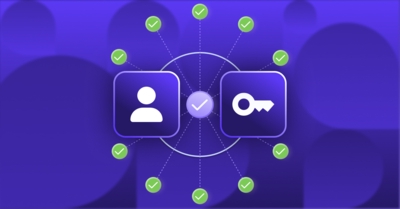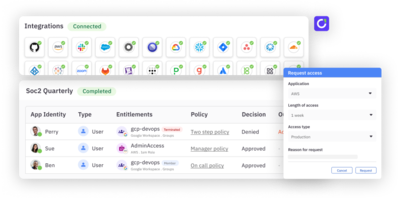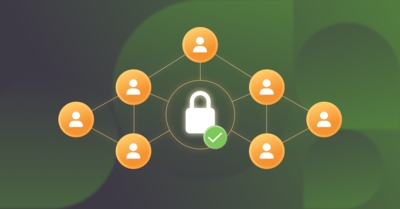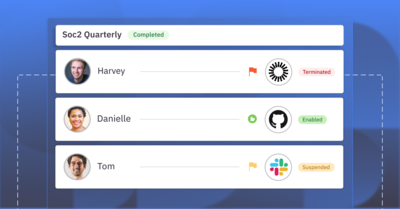Cloud-Based Identity and Access Management Explained
With widespread cloud adoption, the traditional network perimeter has vanished, replaced by a complex ecosystem of public clouds, SaaS apps, and the realities of remote work. This shift demands a modern approach to security that places identity at the very center of its strategy.
Cloud-based identity and access management (IAM) is a critical business enabler that underpins the security, efficiency, and scalability of every cloud-native organization.
This guide will explain the fundamentals of cloud IAM and the best practices for implementing a robust strategy to protect your digital assets in the cloud.
What is cloud identity and access management?
Cloud identity and access management (cloud IAM) is a framework of policies and technologies designed to ensure that the right entities have the right level of access to the right cloud resources, at the right time. It is the security discipline that manages and controls the digital identities of both your human users (employees, contractors) and your growing workforce of non-human entities (service accounts, API keys, AI agents).
At its core, cloud IAM performs two primary functions:
- Identity management: It acts as a central authority for creating, managing, and authenticating all digital identities across your entire cloud and SaaS environment.
- Access management: It enforces policies to control what each authenticated identity is authorized to do. This involves granting, denying, and revoking permissions to specific cloud resources, such as virtual machines, databases, and storage buckets.
Modern cloud IAM solutions provide a single, unified platform to manage these functions across multiple cloud providers like AWS, Azure, and Google Cloud, as well as the hundreds of SaaS applications your organization uses.
Why is cloud identity management important?
The importance of a robust cloud IAM strategy has grown exponentially with the adoption of the cloud itself. Without it, organizations are exposed to significant security risks and operational inefficiencies.
Here are the key reasons why it’s so critical:
- It secures the identity as the perimeter: In the cloud, identity is the new security perimeter. Attackers no longer need to breach a network; they just need to steal a single, over-privileged credential to gain access to your most sensitive data. Cloud IAM provides the necessary controls, like multi-factor authentication (MFA) and zero trust policies, to protect against these modern threats.
- It enables productivity and speed: A well-implemented cloud IAM system automates the process of granting access to resources. This means new employees and developers can get the access they need in minutes, not days, allowing them to be productive immediately without waiting on manual IT tickets.
- It simplifies compliance and auditing: With Gartner projecting that 99% of cloud security failures will be the customer’s fault through 2025, often due to identity misconfigurations, a centralized IAM platform is crucial. [*] It simplifies access reviews and policy enforcement, making it dramatically easier to generate the reports needed to satisfy auditors and meet regulatory requirements like GDPR.
- It improves user experience: By integrating with tools like single sign-on (SSO), cloud IAM reduces password fatigue and simplifies the login process for end-users. This not only makes them happier and more efficient but also encourages better security hygiene by reducing the temptation to reuse weak passwords.
How does cloud identity and access management work?
Cloud IAM operates as a policy-driven control plane that intercepts and evaluates every access request to your cloud resources. The entire process is a high-speed, automated workflow designed to enforce security policy at scale without manual intervention.
At a high level, the operational flow for any access attempt follows these distinct architectural stages:
- Authentication: An identity (human or machine) presents its credentials to an endpoint. The cloud IAM system validates these credentials against a trusted identity provider (IdP) to verify the identity’s authenticity. This stage confirms who is making the request.
- Authorization: Following successful authentication, the system evaluates the request against a set of predefined access policies. The authorization engine correlates the verified identity, the target resource, the requested action, and the environmental context (e.g., IP address, device posture, time of day) to determine if the action is permitted. This stage determines what the identity is allowed to do.
- Enforcement: Based on the policy decision, the request is either permitted to proceed or explicitly denied. This enforcement is executed at the resource level, ensuring that even if a request bypasses one layer, the policy is still enforced at the final destination.
- Auditing: Every authentication and authorization decision, whether granted or denied, is recorded in immutable logs. This provides a comprehensive audit trail for compliance, security monitoring, and forensic analysis.
This continuous cycle of authentication, authorization, and auditing forms the foundation of a zero trust security posture in the cloud, where access is never assumed and must be explicitly verified for every single transaction.
Key components of cloud IAM
A comprehensive Cloud IAM architecture is composed of several interoperable components, each serving a critical function in the overall security framework.
- Identity Provider (IdP): The authoritative source of truth for all digital identities and their associated attributes. The IdP is responsible for the full lifecycle management of identities and serves as the trust anchor for all authentication processes.
- Authentication service: The service responsible for validating identity credentials. It handles a range of authentication protocols (SAML, OIDC, Kerberos) and methods, from basic passwords to advanced, phishing-resistant factors like FIDO2/WebAuthn and other forms of MFA.
- Policy Decision Point (PDP): This is the core authorization engine. The PDP ingests identity context from the IdP and environmental signals to evaluate access requests against the established security policies. It is responsible for making the real-time “permit” or “deny” decision.
- Policy Enforcement Point (PEP): The component that enforces the decision made by the PDP. PEPs are typically deployed as agents, proxies, or API gateways that sit in front of resources and are responsible for blocking or allowing traffic based on the PDP’s instructions.
- Policy Administration Point (PAP): The centralized management console for defining and maintaining access policies. This is where security administrators and IAM architects codify the organization’s access control rules as machine-readable policies.
- Audit service: The system that aggregates, normalizes, and stores all log data from the other IAM components. It provides the visibility required for security operations, threat hunting, and demonstrating compliance to auditors.
Best practices for cloud identity management
A robust cloud IAM strategy is not a single product but a continuous program built on a foundation of core principles. To effectively manage risk in a distributed, cloud-native environment, organizations must adopt a set of strategic best practices.
Enforce a zero trust architecture
The foundational principle is to “never trust, always verify.” All access requests, whether from users or machines, inside or outside the network, must be rigorously authenticated and authorized. This requires a shift from perimeter-based security to an identity-centric model where every transaction is treated as potentially hostile until proven otherwise.
Related →A Practical Approach to Achieving Zero Standing Privileges (ZSP) - ConductorOne
Implement the principle of least privilege (PoLP) universally
Grant the absolute minimum permissions required for an identity to perform its function. This is especially critical in the cloud, where a single compromised, over-privileged account can lead to a catastrophic breach. Standing privileges should be the exception, not the rule.
💡Pro tip: Use automated tools to discover and right-size existing permissions. Many organizations find that a significant percentage of their IAM roles are over-provisioned. A recent report from Orca Security noted that in 35% of organizations, over 10% of IAM roles had been inactive for at least 90 days, representing an unnecessary risk. [*]
Automate the entire identity lifecycle (JML)
Manual provisioning and de-provisioning are operationally inefficient and a primary source of security risk. Integrating your IAM platform with your HR system of record helps streamline the onboarding process and ensures that access is automatically granted when an employee joins, modified when their role changes, and revoked instantly upon termination to prevent orphaned user accounts.
Utilize just-in-time (JIT) access for all privileged operations
Eliminate standing administrative privileges by implementing JIT access. With JIT, users request temporary, elevated permissions on-demand for a specific task and a limited time. This dramatically reduces the attack surface and mitigates the risk of a compromised privileged account.
Unify governance over all identity types
Your IAM strategy and identity governance must extend beyond human users to encompass the explosive growth of non-human identities (workloads, service accounts, AI agents). Recent estimates suggest non-human identities (NHIs) now outnumber human ones by a factor of 45-to-1, and that number is only increasing. [*] As agentic AI becomes increasingly prevalent, the number of NHIs will skyrocket. These must be discovered, inventoried, and brought under the same governance controls as human identities.
Related →Identity Lifecycle Management for Non-Human Identities
How to choose the right cloud IAM solution
Selecting a cloud IAM platform is a long-term strategic decision. The right IAM solution should not only solve today’s problems but also be flexible enough to adapt to future challenges. When evaluating vendors, consider the following key criteria:
- Breadth and depth of integration: The platform must connect to your entire technology stack, not just a subset of it. This includes deep, API-level integration with every cloud platform (AWS, Azure, GCP), critical SaaS applications, on-premises systems like Active Directory, and custom-built applications. Look for a rich library of pre-built connectors and a robust framework for building custom integrations.
- Support for modern security models: The solution must be architected around zero trust principles. This means it should natively support capabilities like policy-as-code for authorization, and ephemeral, just-in-time access, rather than treating them as afterthoughts.
- Automation and intelligence: A modern IAM platform should be an automation engine. Evaluate its ability to automate complex workflows for lifecycle management, access reviews, and policy enforcement. Furthermore, look for solutions that use AI and machine learning to provide intelligent insights, such as identifying risky permissions or providing recommendations to access reviewers.
- Unified governance plane: The platform should provide a single console to manage policies and gain visibility across all identity types and environments, including multi-cloud and hybrid. Fragmented visibility from multiple tools is a significant operational burden and security risk. A 2025 Fortinet report found that 97% of cybersecurity professionals prefer unified platforms to ensure policy consistency and visibility. [*]
- Scalability and performance: Ensure the solution is built on a cloud-native architecture that can scale to support millions of identities and thousands of transactions per second without performance degradation. Inquire about its multi-regional architecture and resilience capabilities.
- User and administrator experience: A platform that is difficult to use will not be adopted effectively. Evaluate the experience for both end-users requesting access and for the administrators and developers who will be managing the system daily. A streamlined, intuitive interface is crucial for reducing operational overhead and encouraging adoption.
From cloud IAM strategy to enforcement
Architecting a modern cloud identity strategy is a critical first step. However, enforcing that strategy consistently across a fragmented ecosystem of IaaS platforms, SaaS applications, and legacy systems is where most organizations encounter significant risk and operational friction. The gap between policy and real-world enforcement is where security fails.
ConductorOne provides unified governance to bridge that gap. Our AI-native identity platform is engineered to translate zero trust policies into automated, enforceable actions across your entire stack from a single point of control. We move you beyond theory and into a state of continuous compliance and security by enabling you to:
- Achieve true least privilege with native, ephemeral just-in-time (JIT) access for all critical cloud infrastructure and applications.
- Automate complex governance tasks, from identity lifecycle management to access reviews, freeing up critical engineering resources to focus on innovation instead of administration.
- Gain a unified view of all identities, both human and non-human, allowing you to discover, govern, and secure service accounts, AI agents, and API keys with the same rigor as your human users.
- Drastically reduce your cloud attack surface and provide a comprehensive, immutable audit trail of every access decision to satisfy auditors and regulators.
Learn how ConductorOne can operationalize your cloud identity strategy and deliver measurable improvements in your security posture and operational efficiency.
Cloud IAM FAQs
What are the key benefits of moving from on-premises IAM to cloud services?
Moving IAM to cloud services offers several key advantages, including lower total cost of ownership by eliminating hardware maintenance, greater scalability to handle growing numbers of user identities and apps, and faster deployment of new features. A cloud-native solution is also better architected to provide secure access to other cloud services and can more easily adapt to modern security challenges across different cloud environments.
What is the most effective way to implement least privilege in a complex cloud environment?
Achieving least privilege in the cloud requires a layered approach that goes beyond static permissions. The foundation is typically role-based access control (RBAC), which provides a broad but manageable structure for assigning access rights. However, for a mature strategy, security teams must refine this with more granular policies that consider context (like device or location). For the highest-risk permissions, such as administrator roles, you must move beyond standing privileged access entirely and implement just-in-time (JIT) access, where permissions are granted temporarily and on-demand.
How does a mature cloud IAM program directly help prevent data breaches?
A mature Cloud IAM program acts as a primary defense against data breaches by addressing the root causes of many security incidents. It hardens the overall identity security posture in two key ways.
- It prevents initial compromise by enforcing strong MFA, making it much harder for attackers to leverage stolen credentials.
- It minimizes the “blast radius” if a compromise does occur.
By strictly enforcing least privilege, it ensures that a compromised account has very limited permissions, preventing attackers from moving laterally to access sensitive data and stopping unauthorized access from escalating into a major breach. This is a cornerstone of modern data protection.
What key capabilities differentiate modern cloud access management solutions?
Modern cloud access management solutions are architecturally different from legacy tools built for on-prem environments. The key differentiators are a focus on automation and dynamic policy enforcement. This includes:
- Automated lifecycle management: Goes beyond basic user provisioning to handle complex “mover” scenarios and immediate de-provisioning, which is critical for ensuring only authorized users retain access.
- Context-aware authorization: The ability to make dynamic user access decisions based on real-time signals, not just a static role.
- Native JIT access: Providing ephemeral, on-demand access as a core function, rather than simply vaulting credentials.




